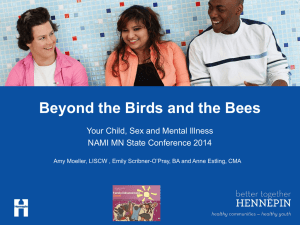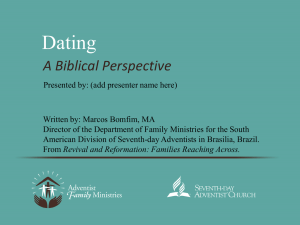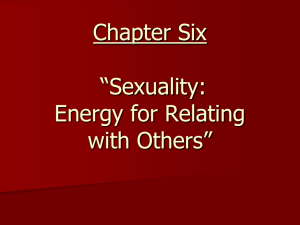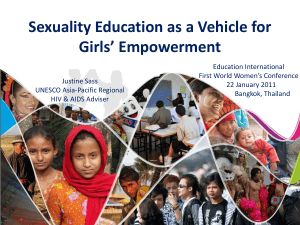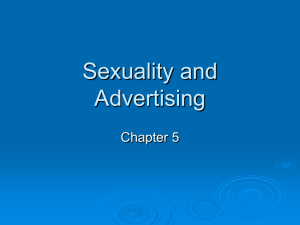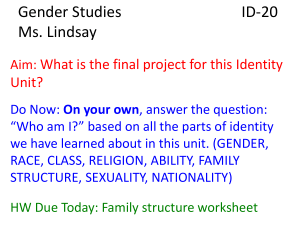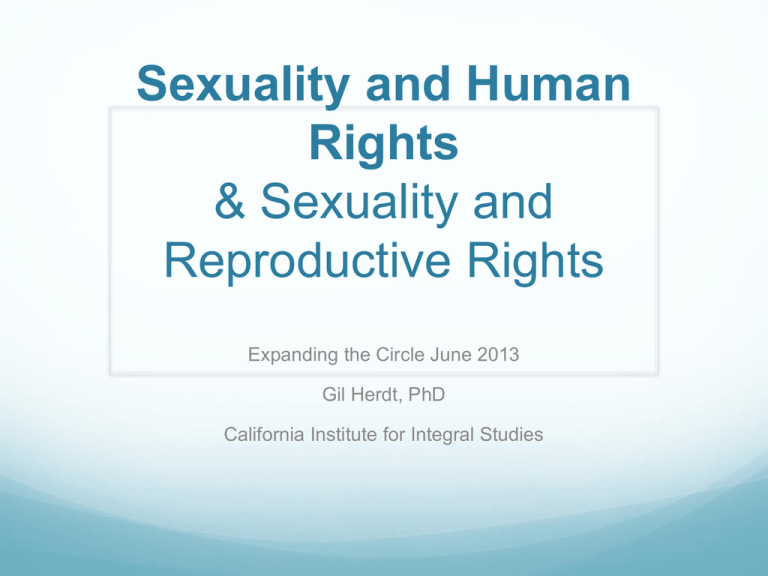
Sexuality and Human
Rights
& Sexuality and
Reproductive Rights
Expanding the Circle June 2013
Gil Herdt, PhD
California Institute for Integral Studies
Rights are in the media
What are human rights?
To deny people their human rights is to challenge their
very humanity.
--Nelson Mandela
America did not invent human rights. In a very real
sense human rights invented America.
--Jimmy Carter
Sexuality Rights Are for
Everyone, Not Just Some
Our approach is to be inclusive of all peoples
regardless of ethnicity, gender, social class, national
origin, faith & other factors
In the past, when people heard the term “rights” they
may have associated it with “special rights” – such as
for LGBT people
Today, rights are defining a new approach to human
sexuality in self, society and culture
This framework is going to define future education,
research and social justice
Research supports the
Sexuality Rights approach
Research reveals that when people feel safe and secure in
their right to pursue their individual sexual pleasure,
reproductive potential, and expression of sexual and gender
identity, they are healthier in general and are better able to
attain their full potential as human beings (Institute of
Medicine, 2011; UN, 2012).
This is especially true of their sexual health, well-being and
behavior (Coleman, 2010; Correa, et al, 2005; Correa, et al
2009; Herdt, 2004; Petchesky, 2003).
When sexuality is defined as a right in society, it helps
people to do better in life (Aggleton & Parker, 2010)
In the classroom: rights and
human sexuality
1) Increasingly human rights define how people think
and feel about sexual expression – a generational shift
is now occurring
2) The great majority of young people, according to
polls, endorse human rights and extend them to such
issues as same-sex marriage rights
3) Gender identity and reproductive rights are also
powerful and while controversial, they provide great
teaching moments in the classroom
One Good Picture is Worth a
Thousand Words
US example – Shelby Knox In Texas worked in her own
high school to help her community support
comprehensive sexuality education because of the
epidemic of STIs going around
This story opens Chapter 1
“GAY RIGHTS ARE HUMAN RIGHTS AND HUMAN
RIGHTS ARE GAY RIGHTS.” –
Hon. Hillary Clinton, Secretary of State (Dec. 2011)
The USA Evolves Its Sexual
Rights Position
Secretary of State Hillary Clinton –United Nations
US and other nations have declared discrimination
against gays, lesbians, bisexuals, trans, and queer
people harmful to health and well-being (2011)
In Feb. 2012, President Obama declared his support
for same-sex marriage rights
Pres. Obama’s Inauguration speech (2013) extends
sexuality rights into basic civil rights
Defining human rights
The freedoms to which all humans are entitled, such
as the freedoms of speech and religion, and the most
basic right of all, to life. They are based on the
inherent rights of freedom, dignity, and equality of all
human beings – sexuality included (Aggleton and
Parker, 2010).
Sexual rights violations
Human rights violations include offenses that can
destroy sexual well-being, and possibly life itself. These
violations may include forcing people to have abortions
or to be sterilized, denying people the right to
contraceptives, executing or imprisoning people
because of their sexual or gender orientations, forcing
people to have their genitals altered, as well as many
forms of rape and sexual coercion (Aggleton & Parker,
2010; Correa et al., 2009; Hunt, 2007; Joffe, 2009). All
these examples are violations of rights related to sex,
reproduction, or gender and sexual orientation.
Students want to understand
Sexuality Rights
Today’s students follow social media stories about
human rights abuses
But students don’t always connect the dots between
abuses and people’s needs for holistic sexual wellbeing
Students don’t have a complete language yet for how
to talk about Rights in their own lives
Sexual literacy and sexual-well being provide one
approach for them to integrate these issues into their
whole lives
Basic sexuality rights*
The right to learn and teach about sex
The right to respect people’s bodies just as they are
The right to be sexually active or not
The right to choose when and how to have children—or not
The right to pursue sexual pleasure in a safe and satisfying way
The right to express your own sexual orientation without fear or
punishment
*Source: Correa et al. (2009); Irvine (2002)
Human Rights and Personal
Responsibility
As the Surgeon General’s Report (2001) said, having
respect, freedom and dignity also comes with
responsibility
The need to be and act responsibly when it comes to
sexual choices and decisions, as for example, the use
of a condom to protect a partner from disease or
unintended pregnancy
This freedom can be used or abused – and so it calls
for holistic sexuality into all aspects of someone’s life
How holistic sexuality
connects to Rights
We have defined holistic sexuality as the integration
of body, mind, feelings and social life through sexuality
When a person’s Rights are denied or undermined,
they are unable to achieve holistic sexuality, as for
example, when people feel the dignity and freedom to
pursue their sexual needs safely
Understanding Rights can enable students to see how
to better achieve holistic health and sexual well-being
in a responsible way
Reproductive Rights in the
News
Increasing numbers of laws to restrict contraceptives
Only yesterday, the state of Arkansas passed the most
restrictive abortion law in the U.S., banning the
procedure after 12 weeks of pregnancy with certain
exceptions.
We think these policies are based on a basic lack of
understanding and sexual literacy in the USA
Reproductive Rights Today
Experts advise that knowledge of and access to contraceptives is a powerful
tool in ensuring sexual and reproductive health and well-being (Cook &
Fathalla, 1996; Correa et al., 2009; Petchesky, 2003).
Reproductive health rights are often a reflection of women’s status and social
position in a society (DiMauro and Joffe, 2009)
Women who have sought reproductive choices have often dealt with severe
hostility, stigma, and even violence (Correa et al, 2009)
This is striking when women decide not to have children in countries that are
not very supportive of reproductive rights (Petchesky, 2003)
Providing reproductive health and choices that are safe, affordable, and
accessible are cornerstones of UN policy (Correa et al., 2005; 2009).
Summing Up
Sexuality rights is a basic approach to all human
sexuality in the USA and globally
Research supports this teaching approach
A generational shift is occurring among young people
that suggests this approach will become increasingly
relevant in the future
Sexuality and reproductive rights affirms our basic
humanity and inclusion of all people
Human Sexuality:
Building a just society
I believe all Americans who believe in freedom,
tolerance and human rights have a responsibility to
oppose bigotry and prejudice based on sexual
orientation.
Coretta Scott King



